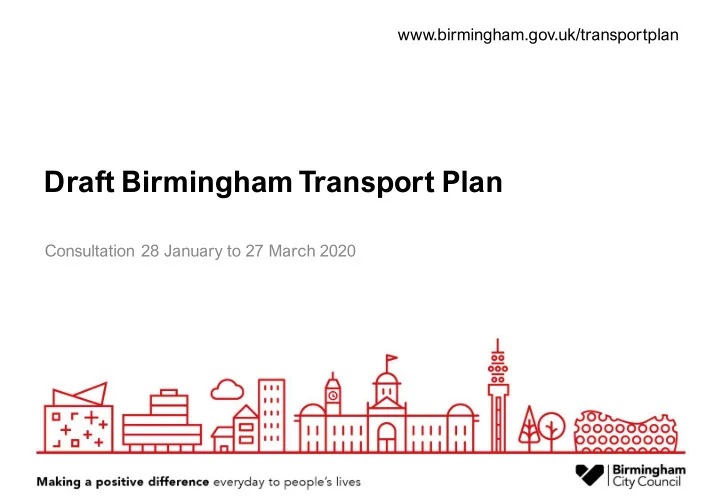

www.birmingham.gov.uk/transportplan Draft Birmingham Transport Plan Consultation 28 January to 27 March 2020
www.birmingham.gov.uk/transportplan Context ▪ Climate emergency - carbon neutral Birmingham by 2030 ▪ Air quality – going beyond the legal minimum requirements ▪ Accommodating future growth – population and economy ▪ Grasping opportunities – Birmingham welcomes investment ▪ New technologies and better data ▪ Travel Demand Management approach to encourage change PAGE 2
www.birmingham.gov.uk/transportplan Vision The vision for Birmingham’s transport is for a sustainable, green, inclusive, go-anywhere network. Safe and healthy environments will make active travel – walking and cycling – the first choice for people making short journeys. A fully integrated, high quality public transport system will be the go-to choice for longer trips. A smart, innovative, carbon neutral and low emission network will support sustainable and inclusive economic growth, tackle climate change and promote the health and well-being of Birmingham’s citizens. This vision will be delivered through four big moves… PAGE 3
www.birmingham.gov.uk/transportplan Reallocating road space The allocation of road space will change away from single occupancy private cars to support the delivery of a public transport system fit for a global city, fundamentally changing the way that people and goods move around the city. 25% of all car journeys undertaken by Birmingham residents are less than a mile. PAGE 4
www.birmingham.gov.uk/transportplan Reallocating road space Key delivery components: Bus priority measures (including bus lanes) ▪ Sprint rapid transit network ▪ Extended Metro network ▪ Remodelling urban centres ▪ Segregated cycle routes ▪ Regional Transport Co-ordination Centre ▪ Around 259 million journeys were made on local buses in the West Midlands in 2017/18. PAGE 5
www.birmingham.gov.uk/transportplan Transforming the city centre The city centre of Birmingham will be transformed through the creation of a network of pedestrian streets and public spaces integrated with public transport services and cycling infrastructure. Access to the city centre for private cars will be limited with no through trips. This includes Birmingham welcomed looking at different options for the 41.8 million visitors in 2017 bringing a visitor spend of central section of the A38 including £7.1 billion. re-routing it to an upgraded ring road. PAGE 6
www.birmingham.gov.uk/transportplan Transforming the city centre Key delivery components: Traffic cells initiative ▪ Considering different options for the A38 ▪ Introducing cross city buses ▪ New public open spaces ▪ Improvements to Snow Hill and Moor ▪ Street stations Improving cycling and walking ▪ infrastructure The average Birmingham Management of servicing and deliveries ▪ driver lost 134 hours to Release car parking space for ▪ congestion in 2018. redevelopment PAGE 7
www.birmingham.gov.uk/transportplan Prioritising active travel in local neighbourhoods Active travel – walking and cycling – will become how most people get around their locality most of the time. Cars will no longer dominate street life around homes and schools. A limit of 20mph will be standard on all local roads. Residential neighbourhoods and local centres will be places where people are put first. More than one in four of Birmingham’s residents is obese – the highest instance in the UK. PAGE 8
www.birmingham.gov.uk/transportplan Prioritising active travel in local neighbourhoods Key delivery components: 20mph limit for residential streets and local ▪ centres School Streets measures to support safe ▪ active travel School travel plans ▪ Updated residential planning guidelines ▪ Management of servicing and deliveries ▪ Around a third of adults in Pedestrian crossing improvements ▪ Birmingham spend less Green Travel Districts in key areas ▪ than 30 minutes each week on physical activity. PAGE 9
www.birmingham.gov.uk/transportplan Managing demand through parking measures Parking will be used as a means to manage demand for travel by car through availability, pricing and restrictions. Where development potential exists, land currently occupied by car parking will be put to more productive use. In Birmingham, up to 30% of available land is used for parking. PAGE 10
www.birmingham.gov.uk/transportplan Managing demand through parking measures Key delivery components: Workplace Parking Levy ▪ Controlled Parking Zones ▪ Changes to parking prices/tariffs ▪ Parking enforcement ▪ Parking Supplementary Planning ▪ Document Park and ride at suitable locations ▪ The average car sits Release car parking space for ▪ unused for 96% of the time. redevelopment PAGE 11
www.birmingham.gov.uk/transportplan Have your say ▪ Do you agree with the vision and big moves? ▪ Are the delivery components the right ones? ▪ Which are the most important delivery components? ▪ What else should be in the plan? PAGE 12
www.birmingham.gov.uk/transportplan Consultation ▪ Consultation open 28 January to 27 March ▪ Respond online via birminghambeheard.org.uk/economy/transportplan ▪ Public drop in sessions: ▪ Tue 11 Feb, 4pm-7pm, Trinity Centre, Sutton Coldfield, B72 1TF ▪ Sat 22 Feb, 10am-1pm, Council House, city centre, B1 1BB ▪ Tue 25 Feb, 4pm-7pm, Sense Touchbase Pears, Selly Oak, B29 6NA ▪ Wed 4 Mar, 4pm-7pm, Saltley Methodist Church, Saltley, B8 1HU ▪ Stakeholder events (book via birmingham.gov.uk/transportplan): ▪ Wed 26 Feb, 8.30am-10.30am, Council House ▪ Tue 3 Mar, 1pm-3pm, Council House ▪ Targeted meetings for specific groups of people PAGE 13
Recommend
More recommend